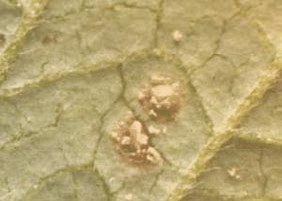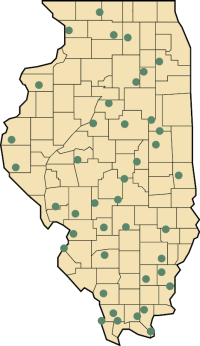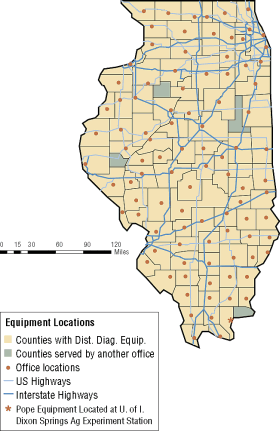Asian Soybean Rust Management: It's Not If, It's When
 |
Suzanne M. BissonnetteVisiting Extension Program Coordinator, Soybean Rust Extension Educator IPM, Center Coordinator Champaign ExtensionPhone: (217) 333-4901 E-mail: sbissonn@illinois.edu |
Asian soybean rust will be a continuing threat to soybean production in the U.S. in the upcoming 2006 growing season and beyond. There are, as it turns out, two species of the soybean rust fungus, Phakopsora pachyrhiza and P. meibomiae. Acknowledging these two species is important because P. meibomiae is less aggressive and much less of a threat to soybean than P. pachyrhiza. The two species can be distinguished with laboratory testing. Unfortunately, P. pachyrhizi, the pathogen that causes Asian soybean rust, has been the pathogen detected in southern states to date.

It is important to recognize the symptoms of soybean rust. Soybean rust doesn't look like your average, common rust of field corn or wheat. As the disease begins, there are two types of lesions that can be observed on the bottom of a leaf. One lesion is a pustule that with a 20X hand lens looks like a little volcano with tan spores produced from the top of the pustule (Figure 1). The other lesion is reddish brown with minimal or no spores evident, also on the underside of the leaves. Soybean rust generally shows up in the lower canopy of the plant first, rather than at the top of plants.
Asian soybean rust was first identified in the U.S. in November 2004. The disease can cause significant defoliation of the plant and subsequent loss in yield, and possibly death of the plant. Our adapted soybean varieties are susceptible to this disease, so early detection and identification is critical for mitigating yield losses. Although the long-term goal is to manage the disease with resistant varieties, resistant varieties have not been developed yet. However, there are significant, ongoing efforts in screening for resistance to the disease that can be incorporated in our adapted varieties. Early detection and application of fungicides, if necessary, currently are only management tools available.
State Taskforce
Before the introduction of the pathogen in North America, a State Taskforce was initiated in Illinois to prepare for the possible introduction of soybean rust to Illinois. The taskforce dealt with numerous issues, including: 1) protocols, such as monitoring, scouting, sampling, and identification; 2) educational issues, such as training and rust education for first responders, field scouts, producers, and agribusiness personnel; 3) plant sampling and diagnosis issues, such as expansion of online sample screening for soybean rust and designation of the U of I Plant Clinic as the state triage site for Illinois; 4) regulatory issues, such as granting of FIFRA Section 18 (emergency) fungicide labels and preparedness of licensed applicators in the state; 5) research efforts; and 6) multiple media issues. The State Soybean Rust Taskforce Plan can be found at http://www.agr.state.il.us/. It has been updated as the disease has progressed. The taskforce continues to address educational, regulatory, and diagnostic issues relevant to soybean rust in Illinois.
Spread of the Disease in 2005

During the 2005 growing season, starting from mid Florida, soybean rust slowly made its way northward through Florida to Alabama, Georgia, Mississippi, North and South Carolina, Louisiana, and Texas. Soybean rust was reported on soybean and kudzu and potentially on Florida beggarweed (not confirmed as of 20 November, 2005). Considerable effort went into monitoring the spread of soybean rust this past season. Soybean producing states each had sentinel field plots that were scouted weekly for the presence of rust. The sentinel plot program, which will continue in 2006, has three functions:1) to quantify the timing of soybean rust spore production in overwintering and growing season source areas (refer to http://www.ces.ncsu.edu/depts/pp/soybeanrust/index.php); 2) to serve as a warning network for new disease observations in the soybean production regions; and 3) to provide a means to collect data for epidemiological research. Results from monitoring are input on the official USDA Soybean Rust website, http://www.sbrusa.net/. National and local maps and individual state commentary are updated regularly, so soybean producers should check the site daily. Numerous first detections were observed in the sentinel plots. The USDA will sponsor the sentinel plot program again in 2006.
Illinois had 40 sentinel soybean plots and one kudzu plot in 2005 (Figure 2). Sentinel plots were funded by the USDA, the United Soybean Board, and the North Central Soybean Research Program (NCSRP). One standard protocol was developed and used for both NCSRP and USDA plots. Sentinel plots were planted with varieties adapted for their locations, with a mix of early and later maturing varieties. If multiple varieties were planted, each variety was planted in four-rows, with no spacing between varieties. Plot size was 50 ft x 50 ft, or larger, with a center area of 30 ft x 30 ft for scouting. The scouting protocol called for scouting weekly before predicted spore arrival and scouting at three- to four-day intervals after predicted spore arrival or after soybean rust was reported in a neighboring state. Scouting would return to weekly intervals after the first confirmed observation in a plot. Observations required and recorded were: GPS location, cultivar description or name, planting date, row spacing, planting density, and field acreage. During each observation date, plant height, degree of canopy closure, and the vegetative and reproductive growth stages were recorded. Severity of the disease was assessed as absent, low, medium, or high.
In Illinois sentinel plots, numerous invaluable cooperators scouted throughout the 2005 growing season. The program will be continued in 2006. The National Soybean Research Lab maintains a website with soybean rust information and as a hub for in-state sentinel plot data reporting for sentinel scouts at http://www.soybeanrust.org/. The data are uploaded to the national USDA website (http://www.sbrusa.net/).
Soybean Rust Pre-screening

In Illinois in 2004, University Illinois Extension designated a specialized section of our University of Illinois Digital Distance Diagnostics Imaging (DDDI) system to aid in early detection of Asian soybean rust. The online service available at all county Extension Unit offices was upgraded in 2005. The DDDI system essentially is an online plant clinic. Our goal with this system, related to Asian soybean rust, is pre-screening and early detection of rust infected plants. Samples can be submitted to the University of Illinois DDDI system at any county Extension Unit office (Figure 3). The results of soybean rust pre-screening via DDDI are available within a few hours. If the DDDI pre-screening is suspect, a plant sample is submitted via overnight mail to the U of I Plant Clinic. A fee is charged to clientele for any mailing costs before detection in the state.
Soybean Rust Education and Information
An unprecedented number of face-to-face educational meetings for a single disease occurred in 2005 for education about soybean rust. Training opportunities by Extension were offered in the areas of first responder training, in-depth soybean scouting clinics, DDDI, fungicide short courses, aerial application fly-in, regulatory issues, applicator licensing, diagnosis training, and update seminars.
Printed and online educational materials developed included a news release series (http://www.ipm.illinois.edu/fieldcrops/soybeans/diseases.html), in-season articles in the Bulletin (http://www.ipm.illinois.edu/bulletin/index.php), fungicide spray recommendations fact sheet, NC IPM soybean rust fact sheets (http://www.aphis.usda.gov/lpa/issues/sbr/Soybean_Rust_22.pdf), and a NCR 504 scouting brochure (http://www.aphis.usda.gov/lpa/issues/sbr/SBR_IDcard_11-04.pdf) University of Illinois Extension printed resources for soybean rust can be ordered online at pubsplus.illinois.edu, or by calling 800-345-6087. All soybean producers and scouts should have a Field Crop Scouting Guide (X880d Field Crop Scouting Manual), and the reprinted and updated soybean disease pocket guide (C1380 Pocket Guide to Soybean Diseases). Other useful items are a new soybean rust disease assessment tool (X881 Soybean Rust Assessment Tool) aand a hand lens for soybean rust scouting endeavors (X882, Folding Pocket Magnifier, 20X). A new Extension Report on Plant Disease #1002, "Characteristics of Fungicides for Field Crops", is an excellent resource when decisions about applying fungicides must be made.
In-depth face-to-face training for competent sampling, scouting, identification, reporting, and management of soybean rust by clientele continues this year. Additionally, University of Illinois Extension maintains a Web site with specific soybean rust information for Illinois. Information about the disease, current fungicide information, state soybean rust taskforce information, and information about scouting and sample submission for the disease can be found at this site.
Fungicide selection, application, and regulatory issues will continue to be issues as soybean rust progresses. As of November 2005, our current recommended fungicides for the management of soybean rust were listed in Table 1. Continuation of in-depth training for competent and legal selection and application of fungicides for the management of soybean rust by clientele will continue to be a key component of our educational effort to manage soybean rust in Illinois.
| Table 1 – Illinois Asian soybean rust fungicide
information EPA Soybean Rust Section 3 Fungicides |
||||||||
| Common Name | Fungicide Trade Name | Manufacturer | Rate/Acre | Application (GPA) | Labeled # App's | PHI days | Chemical class | Mode of Action |
| Azoxystrobin | Quadris | Syngenta | 6.2-15.4 fl oz | Adequate coverage & penetration, include crop oil |
1-2 | 14 | Strobilurin | Protectant |
| Chlorothalonil | Bravo Weather Stik | Syngenta | 16-36 fl oz 5-10 air | 20-150 | 1-3 | 42 | Benzonitriles | Protectant |
| Echo 720 | Sipcam Agro | 16-40 fl oz 5-10 air | 20-150 | 1-3 | 42 | |||
| Echo 90DF | Sipcam Agro | 14-32 oz 5-10 air | 20-150 | 1-3 | 42 | |||
| EQUUS 720 SST | Farmsaver.com | 1.37-2.25 lbs | 3 | 42 | ||||
| EQUUS DF | Farmsaver.com | 1.25-2.2 lbs | 10-20 | 3 | 42 | |||
| Pyraclostrobin | Headline | BASF | 6-12 fl oz | Thorough coverage of foliage | 1-2 | 21 | Strobilurin | Protectant |
| EPA Soybean Rust Section 18 Fungicides (section 18's in effect until 11/10/2007) | ||||||||
| Myclobutanil | Laredo EC | Dow Agro-Sciences | 4-8 fl oz | Adequate coverage & penetration | 1-2 | 28 | Triazole | Curative |
| Laredo EW | 4.8-9.6 fl oz | 15-20 5 air |
2 | 28 | ||||
| Propiconizole | Tilt | Syngenta | 4-8 fl oz | 15 5 air |
1-2 | 28 | Triazole | Curative |
| Bumper 41.8EC | Makhteshim- Agan | 4-8 fl oz | 15 5 air |
1-2 | 28 | |||
| Propimax EC | Dow Agro-Sciences | 4-8 fl oz | 15 5 air |
1-2 | 28 | |||
| Tebuconazole | Folicur 3.6F | Bayer | 3-4 fl oz | 10 5 air |
1-2 | 21 | Triazole | Curative |
| Orius 3.6F no label IL | Makhteshim- Agan | 3-4 fl oz | 10 5 air |
1-2 | 30 | |||
| Tebuconazole (unregistered) | Domark 230ME | Valent | 10-13 fl oz | 20-150 5-10 air |
1 | 21 | Triazole | Curative |
| Trifloxystrobin + Propiconizole | Stratego | Bayer | 5.5-10 fl oz | 10 5 air |
1 | 21 | Triazole + Strobilurin | Curative + Protectant |
| Propiconizole + Azoxystrobin | Quilt | Syngenta | 6.2-12 oz | (apply w/0.5% COC) | 1-2 | 21 | Triazole + Strobilurin | Curative + Protectant |
| Propiconizole + Tebuconazole | Headline SBR | BASF & Bayer | 7.8 fl oz | Thorough coverage 5 air |
30 | Triazole + Strobilurin | Curative + Protectant | |